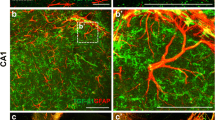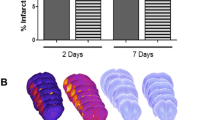Abstract
In response to central nervous system (CNS) injury, and more discretely so also during aging, astrocytes become reactive and increase their expression of the intermediate filament proteins glial fibrillary acidic protein (GFAP) and vimentin. Studies of mice deficient in astrocytic intermediate filaments have provided insights into the function of reactive gliosis. Recently we demonstrated robust integration␣of retinal transplants (1) and increased posttraumatic synaptic regeneration (2) in GFAP−/−Vim−/− mice, suggesting that modulation of astrocyte activity affects the permissiveness of the CNS environment for regeneration. Neurogenesis in the adult mammalian CNS is restricted to essentially two regions, the hippocampus and the subventricular zone. Here, we assessed neurogenesis in the hippocampus of 18-month-old GFAP−/−Vim−/− mice. In the granular layer of the dentate gyrus, cell proliferation/survival was 34% higher and neurogenesis 36% higher in GFAP−/−Vim−/− mice than in wildtype controls. These findings suggest that the adult hippocampal neurogenesis in healthy old mice can be increased by modulating astrocyte reactivity.
Similar content being viewed by others
Author information
Authors and Affiliations
Corresponding author
Additional information
Special issue dedicated to Lawrence. F. Eng.
Rights and permissions
About this article
Cite this article
Larsson, Å., Wilhelmsson, U., Pekna, M. et al. Increased Cell Proliferation and Neurogenesis in the Hippocampal Dentate Gyrus of Old GFAP−/−Vim−/− Mice. Neurochem Res 29, 2069–2073 (2004). https://doi.org/10.1007/s11064-004-6880-2
Accepted:
Issue Date:
DOI: https://doi.org/10.1007/s11064-004-6880-2




